Development of Multi-Tee-Type Precast Concrete Slabs with Insulating Materials for Structural Safety at the Construction Stage
Abstract
Featured Application
Abstract
1. Introduction
2. Test Program
2.1. Test Parameters
2.2. Specimen Design and Fabrication
2.3. Test Conditions and Test Setup
2.4. Strength Prediction of the Specimen
3. Results and Analysis of the Tests
3.1. Material Strength
3.2. Load–Displacement Relations and Overall Behaviors
3.3. Comparison of Tested Strength to Predicted Strength
4. Discussion
5. Conclusions
- In the case of a general multi-tee PC slab at the construction stage, the behavior was governed by flexural failures rather than a shear failure of the dapped end or a member, owing to the slender shapes and high shear-to-span ratio;
- The insulation material (EPS) attached to the bottom of the multi-tee PC slab was intact with the PC slab until the slab’s ultimate failure without any particular damage. This indicates that the adhesion between the insulation and the PC slab could be secured until the ultimate state, as well as at the construction stage;
- The tested-to-predicted flexural strength ratios of the PC slabs at the construction stage were 1.20–1.40. This indicates that the flexural strength can be predicted with an adequate safety margin according to the predicted equations in the current design codes. By excluding the shear contributions of the unanchored shear reinforcement (straight shear reinforcement and lattice shear reinforcement), the shear performance of the PC slab at the construction stage showed a very conservative prediction. Thus, further study is needed to determine the contribution of unanchored shear reinforcement;
- The existing Z-type shear reinforcement at the dapped end showed limited anchorage performance, similar to that of unanchored shear reinforcement. This was because the Z-type shear reinforcement was not anchored into the concrete and had no enclosing flexural reinforcement, resulting in ineffective load transfers at the dapped end;
- The clip-type shear reinforcement proposed in this study at the dapped end showed superior structural performance. Clip-type shear reinforcement improved the anchorage performance because of the enclosed detail and because it was arranged in the same direction as the resultant force of the tensile strut. The closer it was located to the loading point of the dapped end, the more effective the clip-type shear reinforcement was expected to be.
Author Contributions
Funding
Institutional Review Board Statement
Informed Consent Statement
Data Availability Statement
Conflicts of Interest
References
- Yang, L. Design of prestressed hollow core slabs with reference to web shear failure. J. Struct. Eng. 1994, 120, 2675–2696. [Google Scholar] [CrossRef]
- Fellinger, J.; Stark, J.; Walraven, J. Shear and anchorage behaviour of fire exposed hollow core slabs. Heron 2005, 50, 279–301. [Google Scholar]
- Becker, R.J.; Buettner, D.R. Shear tests of extruded hollow-core slabs. PCI J. 1985, 30, 40–54. [Google Scholar] [CrossRef]
- Cuenca, E.; Serna, P. Failure modes and shear design of prestressed hollow core slabs made of fiber-reinforced concrete. Compos. Part B. Eng. 2013, 45, 952–964. [Google Scholar] [CrossRef]
- Girhammar, U.A.; Pajari, M. Tests and analysis on shear strength of composite slabs of hollow core units and concrete topping. Constr. Build. Mater. 2008, 22, 1708–1722. [Google Scholar] [CrossRef]
- Baran, E. Effects of cast-in-place concrete topping on flexural response of precast concrete hollow-core slabs. Eng. Struct. 2015, 98, 109–117. [Google Scholar] [CrossRef]
- Xu, X.; Yu, J.; Wang, S.; Wang, J. Research and application of active hollow core slabs in building systems for utilizing low energy sources. Appl. Energy 2014, 116, 424–435. [Google Scholar] [CrossRef]
- Bertagnoli, G.; Mancini, G. Failure analysis of hollow-core slabs tested in shear. Struct. Concr. 2009, 10, 139–152. [Google Scholar] [CrossRef]
- Mones, R.M.; Breña, S.F. Hollow-core slabs with cast-in-place concrete toppings: A study of interfacial shear strength. PCI J. 2013, 58, 124–141. [Google Scholar] [CrossRef]
- Ibrahim, I.; Elliott, K.; Abdullah, R.; Kueh, A.; Sarbini, N. Experimental study on the shear behaviour of precast concrete hollow core slabs with concrete topping. Eng. Struct. 2016, 125, 80–90. [Google Scholar] [CrossRef]
- Brunesi, E.; Bolognini, D.; Nascimbene, R. Evaluation of the shear capacity of precast-prestressed hollow core slabs: Numerical and experimental comparisons. Mater. Struct. 2015, 48, 1503–1521. [Google Scholar] [CrossRef]
- Lee, Y.-J.; Kim, H.-G.; Kim, M.-J.; Kim, D.-H.; Kim, K.-H. Shear performance for prestressed concrete hollow core slabs. Appl. Sci. 2020, 10, 1636. [Google Scholar] [CrossRef]
- Mohammed, H.A. Optimum Prestressing Amount and Its Effective Force on Prestressed Concrete Double Tee Beam with Web Opening. Int. J. Civ. Eng. Technol. 2019, 10, 1801–1816. [Google Scholar]
- Kumar, P.; Kodur, V.K. A rational approach for fire-resistance evaluation of double-tee, prestressed concrete slabs in parking structures. PCI J. 2020, 65, 20–41. [Google Scholar] [CrossRef]
- Naito, C.J.; Cao, L.; Peter, W. Precast Concrete Double-tee Connections, Part I: Tension Behavior. PCI J. 2009, 54, 49–66. [Google Scholar] [CrossRef]
- Zheng, W.; Oliva, M.G. A practical method to estimate elastic deformation of precast pretopped double-tee diaphragms. PCI J. 2005, 50, 44–55. [Google Scholar] [CrossRef][Green Version]
- Wright, H.E., Jr.; Burns, N.H. Deflection of double tees and hollow-cored slabs with high tension allowed in concrete. PCI J. 1974, 19, 100–118. [Google Scholar] [CrossRef]
- Arockiasamy, M.; Badve, A.; Rao, B.; Reddy, D. Fatigue strength of joints in a precast prestressed concrete double tee bridge. Railw. Age 1991, 36, 84–99. [Google Scholar] [CrossRef]
- Naser, A.F.; Mohammed, H.A. Nonlinear Analysis Comparison to Predict Design Charts for Normal and Lightweight Prestressed Concrete Double Tee Beams. Nonlinear Anal. 2020, 62, 715–731. [Google Scholar]
- Afefy, H.M.; Sennah, K.; Cofini, A. Retrofitting actual-size precracked precast prestressed concrete double-Tee girders using externally bonded CFRP sheets. J. Perform. Constr. Fac. 2016, 30, 4015020. [Google Scholar] [CrossRef]
- Pessiki, S.; Thompson, J. Experimental investigation of precast, prestressed inverted tee girders with large web openings. PCI J. 2006, 51, 2–17. [Google Scholar]
- Kamel, M.R.; Tadros, M.K. The inverted tee shallow bridge system for rural areas. PCI J. 1996, 41, 28–43. [Google Scholar] [CrossRef]
- Piccinin, R.; Schultz, A.E. The Minnesota inverted-tee system: Parametric studies for preliminary design. PCI J. 2012, 57, 162–179. [Google Scholar] [CrossRef]
- Ambare, S.; Peterman, R.J. Evaluation of the Inverted Tee Shallow Bridge System for Use in Kansas; Kansas Department Transportation: Topeka, KS, USA, 2006; p. 99.
- Martindale, G.P. Structural Identification and Assessment of the Inverted Tee Girder Bridge System. Master’s Thesis, University of Nebraska-Lincoln, Lincoln, NE, USA, 2018. [Google Scholar]
- Thompson, J.M.; Pessiki, S. Behavior and Design of Precast Prestressed Inverted Tee Girders with Multiple Web Openings for Service Systems. Civ. Environ. Eng. 2004, 156. [Google Scholar] [CrossRef]
- Polivka, K.A.; Faller, R.; Rohde, J.; Reid, J.; Sicking, D.; Holloway, J. Safety Performance Evaluation of the Nebraska Open Bridge Rail on an Inverted Tee Bridge Deck; Nebraska Department of Roads: Lincoln, NE, USA, 2004; p. 94.
- Han, S.-J.; Jeong, J.-H.; Joo, H.-E.; Choi, S.-H.; Choi, S.; Kim, K.S. Flexural and Shear Performance of Prestressed Composite Slabs with Inverted Multi-Ribs. Appl. Sci. 2019, 9, 4946. [Google Scholar] [CrossRef]
- PCI Concrete Handbook Committee. PCI Design Handbook: Precast and Prestressed Concrete (MNL-120-17); Prestressed Concrete Institute: Chicago, IL, USA, 2017. [Google Scholar]
- Kim, M.-K.; Hong, S.-G.; Lee, J.-M.; Cho, Y.-H. Effect of the spandrel end beams on shear strength behavior in MTS systems. In Proceedings of the Korea Concrete Institute Conference; Korea Concrete Institute: Seoul, Korea, 2008; pp. 189–192. [Google Scholar]
- Wight, J.K.; MacGregor, J.G. Reinforced Concrete Mechanics and Design; Pearson Education, Inc.: Upper Saddle River, NJ, USA, 2012. [Google Scholar]
- Demir, A.; Caglar, N.; Ozturk, H.; Sumer, Y. Nonlinear finite element study on the improvement of shear capacity in reinforced concrete T-Section beams by an alternative diagonal shear reinforcement. Eng. Struct. 2016, 120, 158–165. [Google Scholar] [CrossRef]
- Karayannis, C.G.; Chalioris, C.E. Shear tests of reinforced concrete beams with continuous rectangular spiral reinforcement. Constr. Build. Mater. 2013, 46, 86–97. [Google Scholar] [CrossRef]
- Karayannis, C.; Chalioris, C.; Mavroeidis, P. Shear capacity of RC rectangular beams with continuous spiral transversal reinforcement. Wit Trans. Model. Simul. 2005, 41, 379–386. [Google Scholar]
- ASTM International. Standard Test. Method for Compressive Strength of Cylindrical Concrete Specimens: ASTM C39/C39M-20; ASTM International: West Conshohocken, PA, USA, 2020; p. 8. [Google Scholar]
- ASTM International. Standard Test. Methods for Tension Testing of Metallic Materials: ASTM E8/E8M–16; ASTM International: West Conshohocken, PA, USA, 2016; p. 30. [Google Scholar]
- ACI Committee 374. Guide for Testing Reinforced Concrete Structural Elements under Slowly Applied Simulated Seismic Loads: ACI 374.2R-13; American Concrete Institute: Farmington Hills, MI, USA, 2013; p. 18. [Google Scholar]
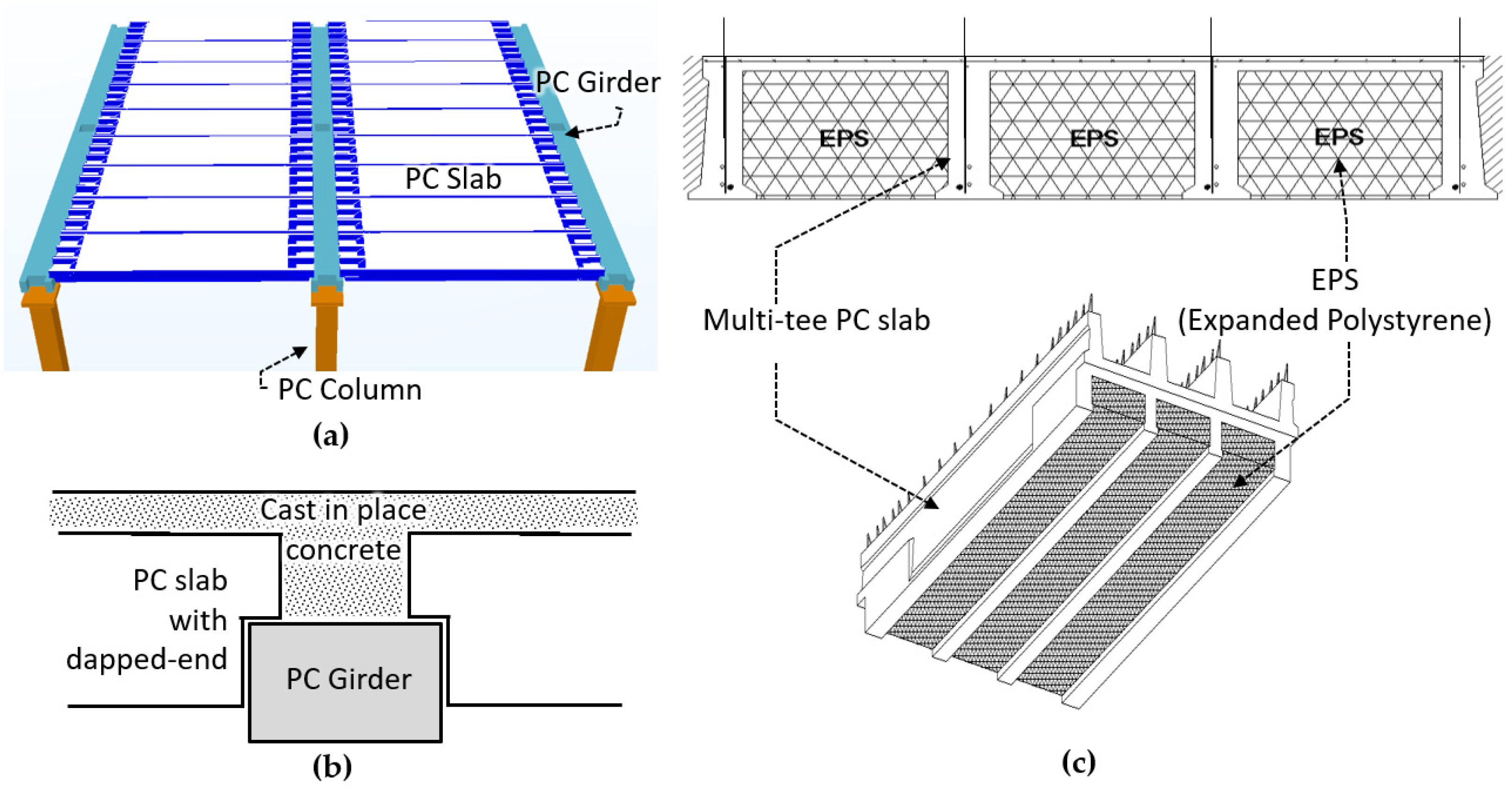



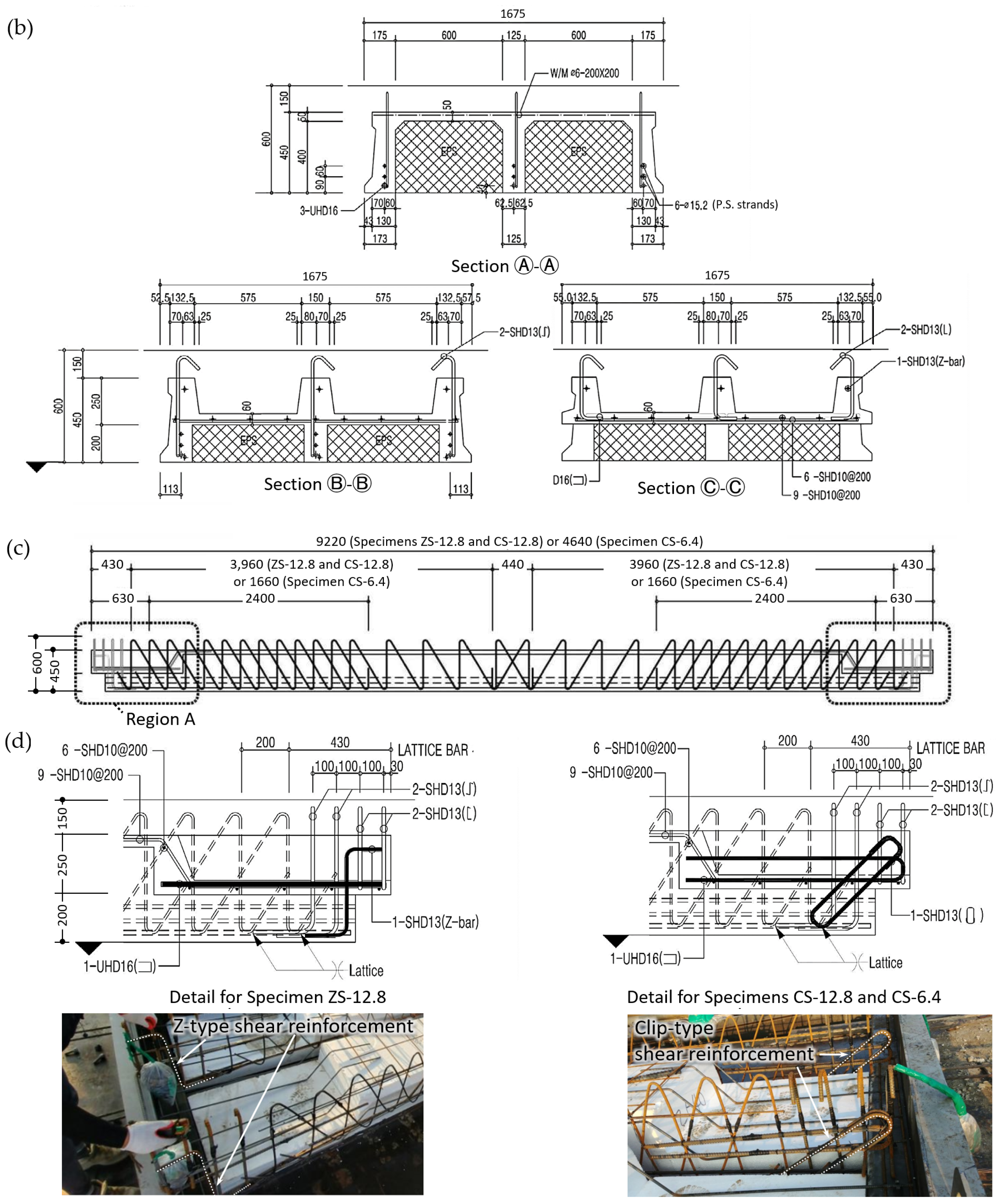




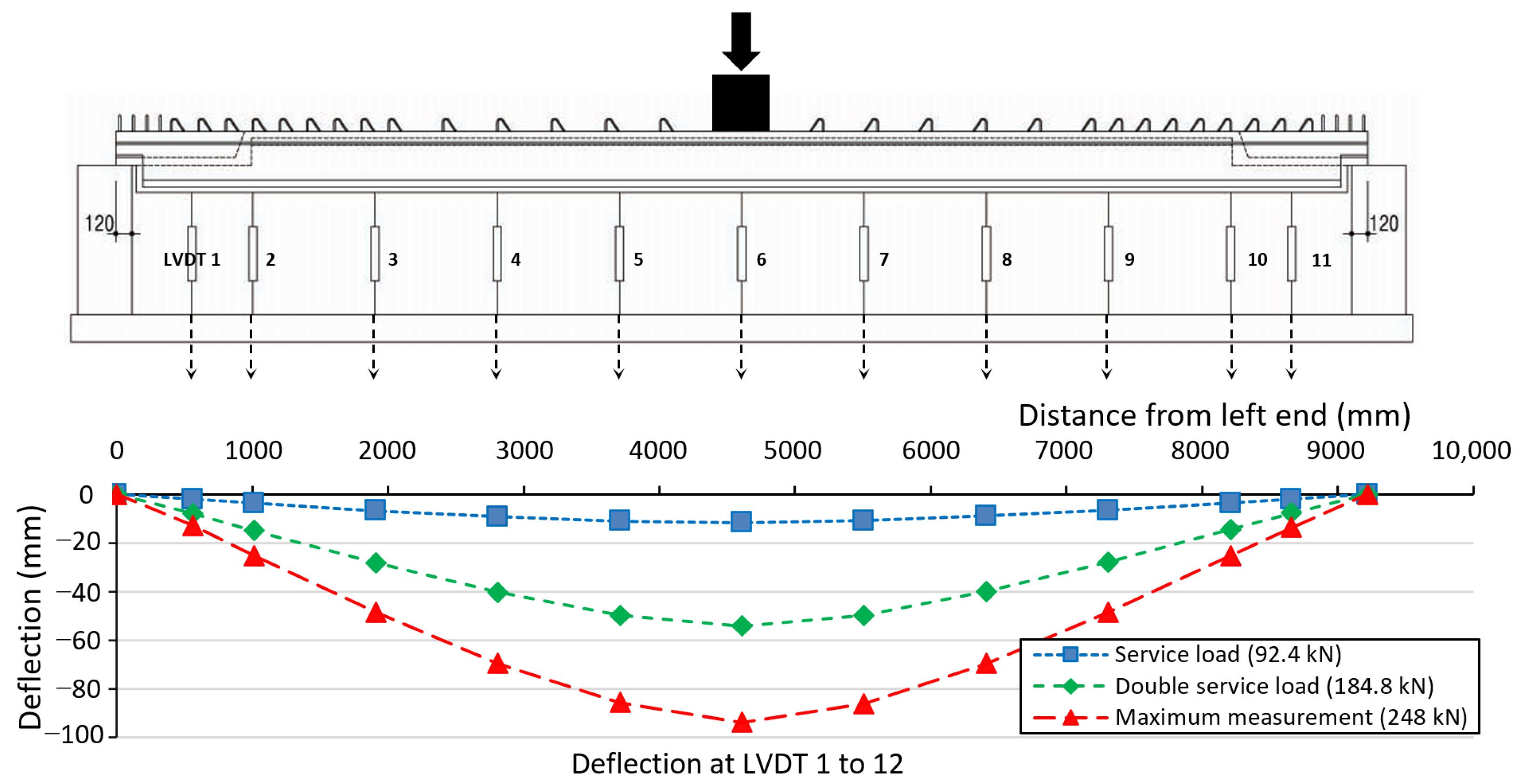
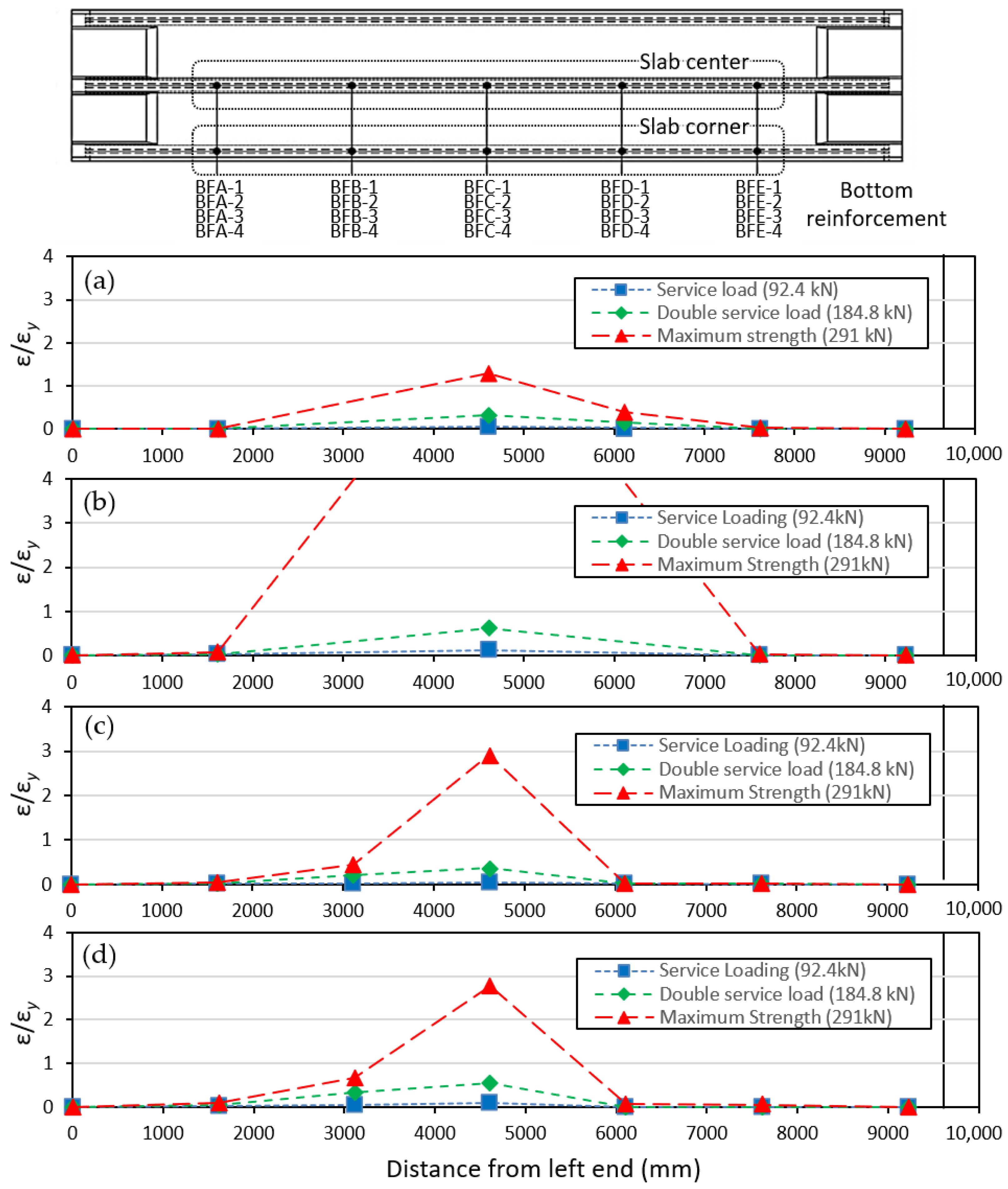

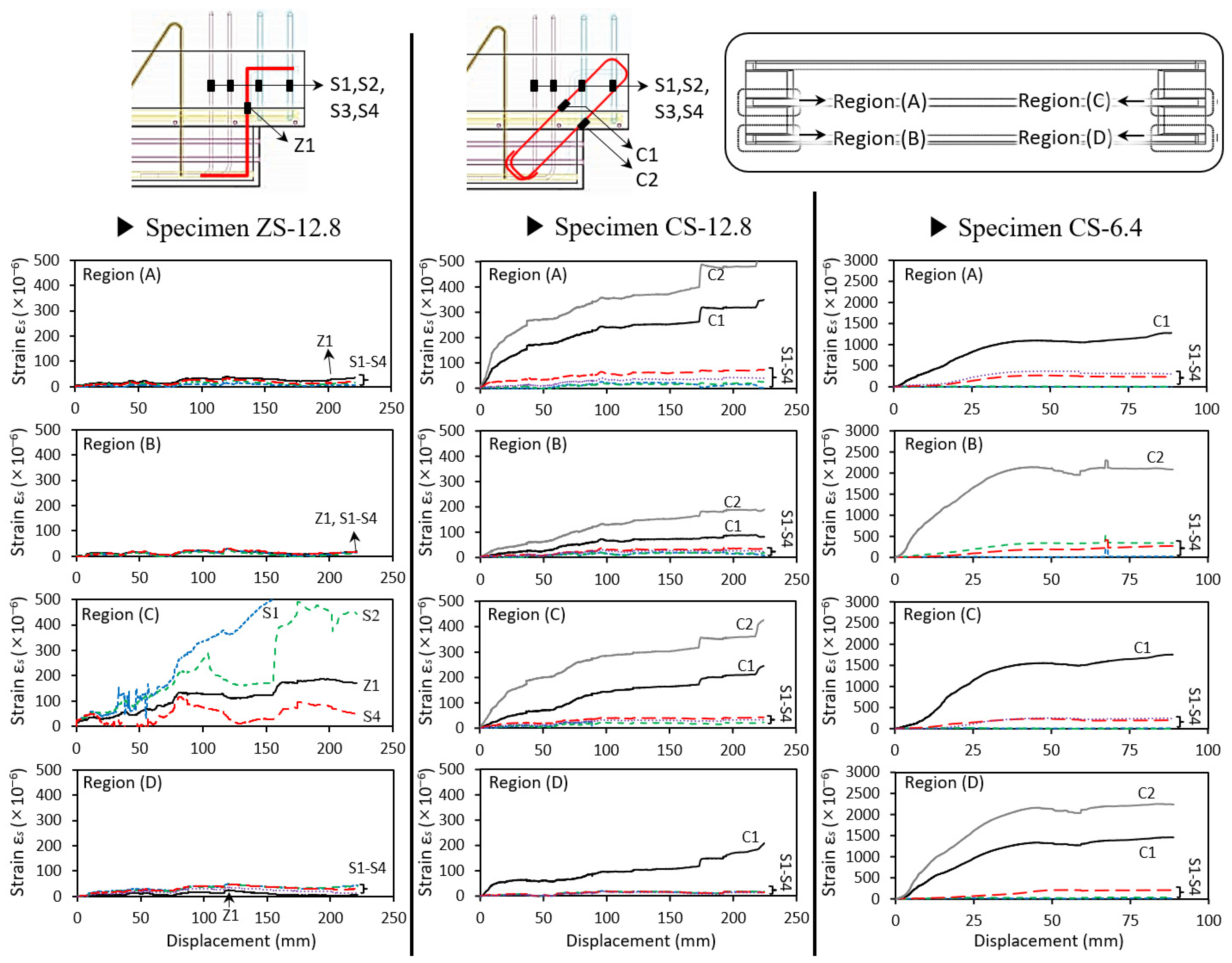
| Specimen | Shear Reinforcement for the Dapped End | Shear-to-Span Ratio (= a/d) 1 |
|---|---|---|
| ZS-12.8 | Z-type reinforcement | 12.8 (4610/360) |
| CS-12.8 | Clip-type reinforcement | 12.8 (4610/360) |
| CS-6.4 | Clip-type reinforcement | 6.4 (2320/360) |
| Specimen | fc′ (MPa) | Predicted Strength | Expected Maximum Load | Test Results | ||||||||||
|---|---|---|---|---|---|---|---|---|---|---|---|---|---|---|
| Flexural Yielding | Shear at PC Slab | Shear at Dapped End | ||||||||||||
| Mn (1) (kN·m) | Pm (2) (kN) | Vc (3) (kN) | Pv-cent (4) (kN) | Vc-dap (5) (kN) | Vn-dap (6) (kN) | Pv-dap(c) (7) (kN) | Pv-dap(n) (8) (kN) | Plower (9) (kN) | Pupper (10) (kN) | Ptest (11) (kN) | Failure Mode (12) | Ptest/Pm (13) | ||
| ZS-12.8 | 50.9 | 613 | 239 | 182 | 312 | 111 | 313 | 169 | 573 | 169 1 | 239 2 | 291 | Flexure | 1.22 |
| CS-12.8 | 59.0 | 617 | 241 | 196 | 340 | 120 | 691 | 186 | 1329 | 186 1 | 241 2 | 289 | Flexure | 1.20 |
| CS-6.4 | 43.9 | 608 | 511 | 170 | 313 | 103 | 675 | 180 | 1323 | 180 1 | 313 3 | 715 | Flexure | 1.40 |
| Nominal Strength (MPa) | W/C (%) | Unit Weight (kg/m3) | ||||
|---|---|---|---|---|---|---|
| W 1 | C 2 | S 3 | G 4 | SP 5 | ||
| 40 | 34.0 | 160 | 471 | 829 | 933 | 4.24 |
| Type | Yield Strength fy | Tensile Strength fu |
|---|---|---|
| D10 | 460.16 | 570.50 |
| D13 | 531.57 | 675.45 |
| D16 | 579.95 | 755.43 |
| Lattice bar | 589.97 | 661.23 |
| Strand Φ15.2 (1860 MPa) | 1733.69 | 1884.39 |
| Specimen | Load (kN) | Drift Ratio (%) | Ductility δu/δy | Secant Stiffness (kN/mm) | Mean Value of Normalized Strain in Z-Type or Clip-Type Shear Reinforcement 1 (ε/εy) | ||||||||||
|---|---|---|---|---|---|---|---|---|---|---|---|---|---|---|---|
| At Py | At Ptest | At Pu | |||||||||||||
| Py | Ptest | Pu | δy | δtest | δu | Ki | Ky | Z1 or C1 2 | C2 3 | Z1 or C1 2 | C2 3 | Z1 or C1 2 | C2 3 | ||
| ZS-12.8 | 218 | 291 | 225 | 1.49 | 4.18 | 4.93 | 3.29 | 7.10 | 3.25 | 0.012 | - | 0.024 | - | 0.027 | - |
| CS-12.8 | 216 | 289 | 214 | 1.56 | 4.21 | 4.95 | 3.17 | 6.86 | 3.09 | 0.040 | 0.083 | 0.073 | 0.131 | 0.098 | 0.154 |
| CS-6.4 | 536 | 715 | 538 | 0.52 | 1.20 | 5.95 | 5.73 | 37.75 | 23.03 | 0.327 | 0.477 | 0.520 | 0.611 | 0.580 | 0.704 |
Publisher’s Note: MDPI stays neutral with regard to jurisdictional claims in published maps and institutional affiliations. |
© 2021 by the authors. Licensee MDPI, Basel, Switzerland. This article is an open access article distributed under the terms and conditions of the Creative Commons Attribution (CC BY) license (http://creativecommons.org/licenses/by/4.0/).
Share and Cite
Baek, J.-W.; Kang, S.-M. Development of Multi-Tee-Type Precast Concrete Slabs with Insulating Materials for Structural Safety at the Construction Stage. Appl. Sci. 2021, 11, 1693. https://doi.org/10.3390/app11041693
Baek J-W, Kang S-M. Development of Multi-Tee-Type Precast Concrete Slabs with Insulating Materials for Structural Safety at the Construction Stage. Applied Sciences. 2021; 11(4):1693. https://doi.org/10.3390/app11041693
Chicago/Turabian StyleBaek, Jang-Woon, and Su-Min Kang. 2021. "Development of Multi-Tee-Type Precast Concrete Slabs with Insulating Materials for Structural Safety at the Construction Stage" Applied Sciences 11, no. 4: 1693. https://doi.org/10.3390/app11041693
APA StyleBaek, J.-W., & Kang, S.-M. (2021). Development of Multi-Tee-Type Precast Concrete Slabs with Insulating Materials for Structural Safety at the Construction Stage. Applied Sciences, 11(4), 1693. https://doi.org/10.3390/app11041693







